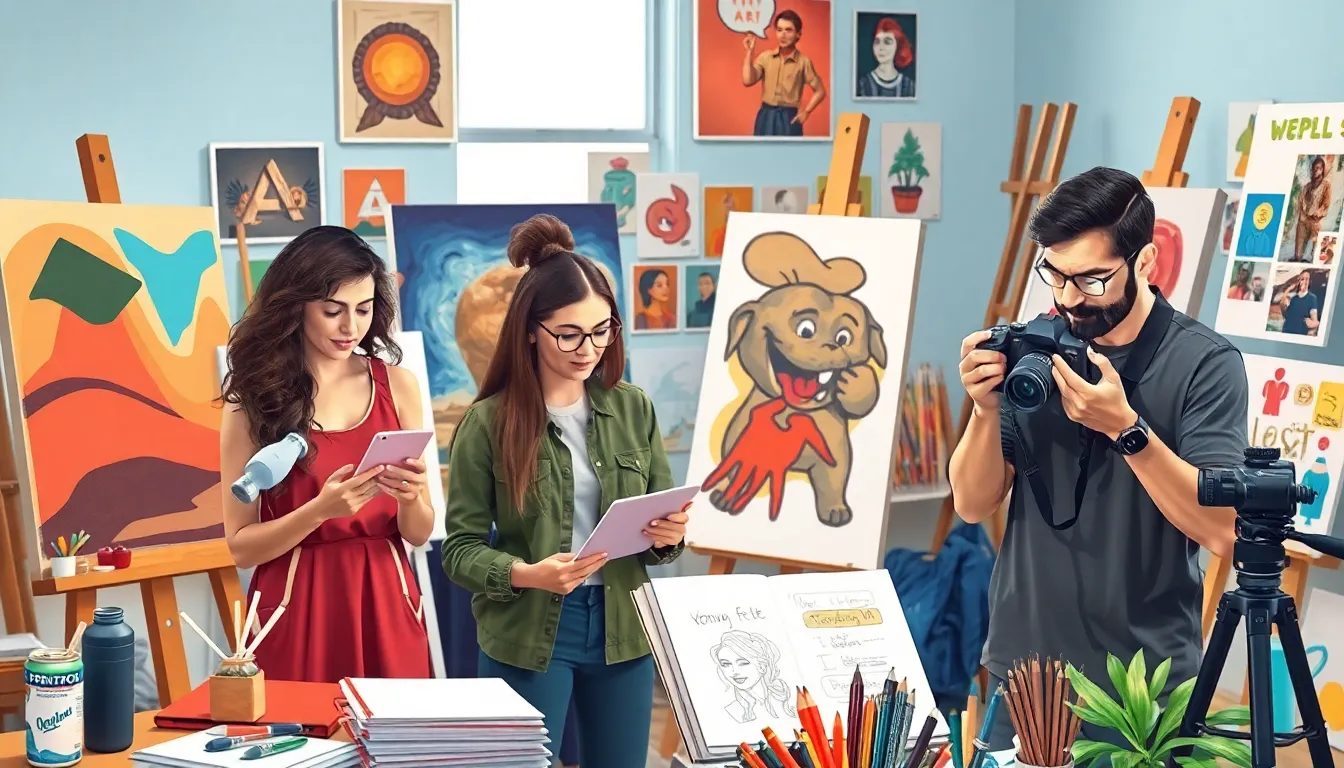In today’s digital age, social media isn’t just a place for cat videos and memes; it’s a vibrant canvas for artists to showcase their work and connect with fans. Imagine turning likes into sales and followers into loyal patrons—all while having a blast. This isn’t just wishful thinking; it’s the reality for countless creatives who’ve cracked the code on social media marketing.
The Importance of Social Media for Artists
Social media plays a crucial role in the visibility and success of artists today. It not only allows them to showcase their work but also fosters meaningful interactions with their audience.
Building an Online Presence
Creating an online presence is essential for artists. Platforms like Instagram and Facebook enable artists to share their portfolios and highlight their creative process. Artists can post images, videos, and updates about their work, keeping their audience engaged. Regular posting attracts followers and builds a community around their artistry. Engaging with followers through comments and direct messages strengthens these connections. Curating content that reflects their style and personality can differentiate artists in a saturated market.
Connecting with Fans and Collectors
Connecting with fans and collectors enhances an artist’s career. Social media provides a space for artists to interact with their audience in real-time, sharing insights and responding to feedback. Artists can organize live sessions or Q&A events, making their followers feel valued and included. Followers become more inclined to support their work, leading to increased sales and potential collaborations. By sharing behind-the-scenes content, artists build trust and enthusiasm, encouraging followers to invest in their work. Effective connections translate to a loyal supporter base and a wider network of opportunities.
Choosing the Right Platforms

Selecting the right social media platforms enhances an artist’s visibility and engagement. Each platform caters to different audiences and serves unique purposes.
Popular Social Media Platforms for Artists
Instagram dominates visual content sharing, making it ideal for artists to showcase portfolios. Facebook connects artists with broader audiences, offering event promotion and community building. Twitter enables quick updates and conversations, engaging fans in real-time. TikTok appeals to younger users, allowing artists to create short, engaging videos that showcase their work creatively. Pinterest serves as a visual discovery engine, promoting artwork through themed boards and links.
Niche Platforms to Consider
Behance specializes in creative showcases, allowing artists to display portfolios in a professional context. DeviantArt focuses on community-driven sharing, catering to artists who want feedback from peers. ArtStation targets digital artists, providing resources and networking opportunities within the industry. Dribbble focuses on graphic design, offering a platform for designers to share work and find jobs. 500px serves photographers, allowing them to showcase high-quality images and connect with fellow photographers.
Strategies for Effective Engagement
Artists can enhance their online presence through targeted engagement strategies. Focusing on content quality attracts attention and fosters community.
Creating Compelling Content
Compelling content captivates audiences and drives engagement. Sharing high-resolution images of artwork highlights details and quality. Artists can also incorporate videos that showcase their creative processes, allowing viewers to experience their artistic journey. Storytelling through captions adds a personal touch, inviting followers to connect emotionally. Encouraging feedback through questions or polls sparks conversation and promotes interaction, making followers feel valued in the creative dialogue.
Utilizing Hashtags and Trends
Hashtags play a crucial role in increasing discoverability on social media. Utilizing relevant hashtags helps artists reach wider audiences and connect with potential fans. Keeping an eye on trending topics allows artists to join broader conversations. Engaging with popular art-related tags, like #ArtInspiration or #ArtistOnInstagram, can amplify visibility. Collaborating with other artists through tag challenges or participating in viral trends can further enhance engagement and broaden reach.
Best Practices for Promoting Artwork
Promoting artwork effectively on social media involves strategic choices and consistent actions. Artists can enhance their visibility and engagement through careful planning and strong connections.
Scheduling and Consistency
Establishing a content schedule increases audience engagement. Artists should post consistently, ideally several times a week, to maintain visibility. Utilizing scheduling tools can automate postings, ensuring content reaches followers even during busy periods. Balancing different content types, such as images, videos, and stories, keeps audiences interested and engaged. Artists often find that engaging with followers in real time, such as during live sessions, strengthens community ties. Responding to comments and messages promptly builds loyalty and trust among fans. Regularity in posting reinforces brand identity, helping artists stay top-of-mind with their audience.
Collaborations and Networking
Building relationships with other artists expands reach and introduces new audiences. Collaborations often lead to innovative projects that can draw attention from both artist’s followers. Engaging with local art groups and online communities fosters networking opportunities, creating spaces for support and inspiration. Participating in collaborative challenges or joint exhibitions can generate buzz, attracting more eyes to their work. Artists might consider hosting giveaways or contests in partnership with peers, which can increase engagement and follower counts significantly. Networking can also facilitate valuable feedback, enriching the artistic process and improving future work.
Social media is an essential tool for artists looking to elevate their careers and connect with audiences. By effectively showcasing their work and engaging with fans, artists can transform online interactions into meaningful relationships and sales opportunities.
Choosing the right platforms and maintaining a consistent posting schedule can significantly enhance visibility and engagement. Through compelling content and genuine interactions, artists can foster a loyal community that supports their creative journey.
Embracing these strategies not only promotes individual artistry but also encourages collaboration and inspiration within the larger artistic community. The potential for growth and connection in the digital age is limitless for those willing to embrace it.
